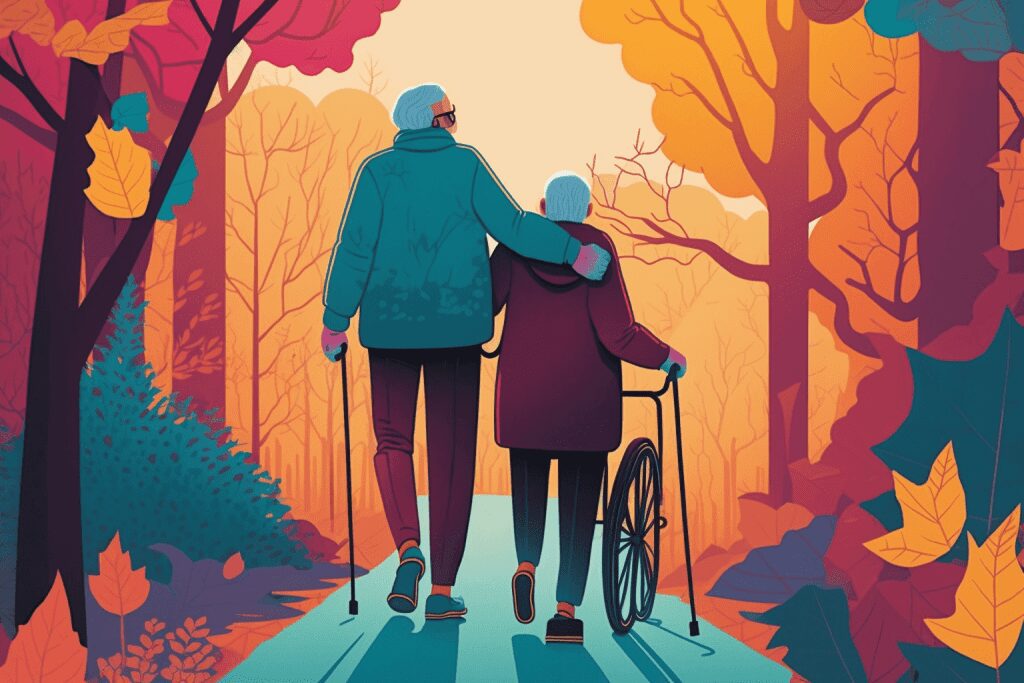In a world rapidly aging, the importance of senior mobility and fall prevention cannot be overstated. This demographic, often overlooked, faces unique challenges that directly impact their quality of life. One such challenge is the high risk of falls, which not only cause physical harm but also instill a persistent fear, curtailing the freedom of movement.
The advent of Artificial Intelligence (AI) has opened new vistas for senior care, including innovative solutions for mobility enhancement and fall prevention. Imagine a world where seniors could defy gravity and stand strong, free of the fear of falling. AI is the catalyst making this scenario increasingly attainable.
However, like any powerful tool, AI in senior care comes with its own set of potential pitfalls. Balancing the transformative potential of AI with its risks is crucial to ensure the technology serves its purpose effectively and ethically. The vast scope of AI in senior mobility, fall prevention, and overall elderly care is an exciting frontier of exploration and innovation. But how exactly can AI redefine aging in place? And what are the challenges we must navigate to make this a reality?
As we delve into these topics, we’ll consider the unique perspectives, merge different subjects, and even entertain some “what if” scenarios. We’ll use relevant, up-to-date examples, and share some personal stories and case studies to support our points. So, buckle up and prepare for an exciting journey into the world of AI and senior care.
AI in Enhancing Mobility for Seniors

Artificial Intelligence, or AI, has ushered in a revolutionary era for senior mobility. It’s not just about wheelchairs and walkers anymore. Instead, we’re entering a world of personalized exercise programs, smart assistive devices, exoskeletons, and continuous mobility pattern analysis—all made possible by AI.
Advantages of AI-Driven Mobility Solutions
The fusion of AI with healthcare has unlocked new possibilities in enhancing senior mobility, a key determinant of their quality of life, independence, and overall wellbeing. Here are some significant advantages of AI-driven mobility solutions:
One of the most potent ways AI enhances mobility is through personalized exercise and rehabilitation programs. AI algorithms can analyze a senior’s physical condition, medical history, and progress to tailor a program that suits their needs and capabilities. These personalized regimens can be more effective and engaging, encouraging seniors to stick to their routines. For example, an AI system might design a program for Mrs. Johnson, a 78-year-old stroke survivor, focusing on exercises to improve her balance and coordination. As she progresses, the AI can adjust the program, ensuring she continues to challenge herself without risk of injury.
AI-driven assistive devices, like smart canes, walkers, or exoskeletons, can significantly enhance seniors’ mobility. These devices use AI to adapt to the user’s movements and provide assistance as needed. For instance, a smart walker could detect when a user is struggling and provide additional support, or an AI-powered wheelchair could navigate obstacles independently. Consider Mr. Smith, an 85-year-old with Parkinson’s disease who struggles with mobility. An AI-powered exoskeleton could help him maintain his ability to walk, providing him with greater independence and improving his quality of life.
AI tools can monitor a senior’s mobility patterns, providing valuable insights for improvement. These systems can detect changes in gait, balance, or speed that might indicate a decline in mobility or an increased fall risk. By identifying these changes early, preventative measures can be taken. Imagine Ms. Lee, a 76-year-old woman living alone. An AI-driven monitoring system could detect that her gait has become unsteady, indicating a possible health issue or increased fall risk. This early detection allows for prompt intervention, potentially preventing falls or addressing health issues before they become serious.
These examples illustrate the transformative potential of AI-driven mobility solutions for seniors. By enabling personalized care, enhancing mobility with smart devices, and providing real-time monitoring and insights, AI has the potential to significantly improve seniors’ mobility and independence. However, while these advantages are impressive, it’s also important to acknowledge and address the potential drawbacks and limitations of AI in senior care, which we will discuss in the next section.
Disadvantages of AI-Driven Mobility Solutions
While AI presents considerable opportunities for senior mobility, it’s important not to overlook the potential downsides. Let’s discuss some of the significant challenges that need to be addressed for AI to truly revolutionize senior mobility. AI-driven mobility solutions, though promising, are often expensive. Exoskeletons, smart wheelchairs, and AI-powered monitoring systems come with a hefty price tag, putting them out of reach for many seniors, particularly those on fixed incomes. While insurance may cover some costs, it often does not cover the entire expense.
For instance, consider the case of Mrs. Smith, an 80-year-old retiree living on a tight budget. She might benefit tremendously from a smart wheelchair or an AI-based fall detection system. However, the high cost of these devices could make them inaccessible to her. Moreover, these technologies are often concentrated in urban areas and developed countries, leaving rural areas and developing regions underserved. Therefore, while AI has the potential to improve senior mobility dramatically, its benefits may not be equally distributed due to economic and geographic disparities.
Another potential downside of AI-driven mobility solutions is the risk of overdependence on technology. While these tools can enhance seniors’ independence, there’s a fine line between assistance and dependence. Excessive reliance on AI for mobility could result in decreased physical activity and a loss of existing mobility skills. For instance, if a senior relies entirely on an AI-powered wheelchair for mobility, they may become less inclined to engage in activities that maintain their physical fitness and mobility, such as walking or exercising. This risk of over-dependence is a significant consideration in implementing AI solutions for senior care.
Finally, and perhaps most critically, are the issues of privacy and data security. AI-driven mobility solutions often rely on continuous data collection and analysis. While this data is invaluable for personalizing care and monitoring health, it also raises serious privacy concerns. Imagine sensors in your home tracking every move, or an AI-powered app having access to your health records. While these tools may improve your quality of life, they also hold intimate details about your daily activities and health conditions. If not properly secured, this data could be vulnerable to breaches, potentially leading to serious privacy violations.
Furthermore, the use of AI in senior care raises ethical questions about informed consent. Do seniors fully understand the extent of data collection involved? Are they aware of the potential risks? It is vital that these questions are addressed, and seniors are given the right to make informed decisions about their care. While AI offers exciting possibilities for improving senior mobility, it is not without its challenges. High costs and limited accessibility can exclude those most in need. Overdependence on technology could lead to a decline in physical abilities, and privacy concerns necessitate stringent data protection measures. Balancing the immense potential of AI with these complexities is crucial for the technology to truly benefit seniors and revolutionize elder care.
AI in Fall Risk Reduction

Falls are a major concern for seniors, with serious consequences that can lead to injury, hospitalization, and decreased quality of life. However, AI has emerged as a promising tool for mitigating these risks, providing innovative solutions for fall detection and prevention.
AI for Fall Detection and Prevention
AI-driven fall detection systems and wearables are a game-changer in senior care. These devices, often in the form of a wristband or pendant, can detect a fall and instantly alert caregivers or emergency services. They employ AI algorithms to distinguish between everyday movements and an actual fall, reducing the chances of false alarms. For instance, Mr. Lee, an 85-year-old living alone, slipped in his bathroom. His fall detection wearable sensed the fall, and within moments, it sent an alert to his daughter living across the city and the local emergency services. This rapid response could make the difference between a minor injury and a life-threatening situation.
AI can also help prevent falls by suggesting home modifications and conducting environmental assessments. Using sensors and AI algorithms, these technologies can identify potential fall hazards in a senior’s home environment. For instance, an AI system could detect frequently used paths within a house and suggest adding railings or removing tripping hazards along these routes.
Imagine Mrs. Lopez, a lively 78-year-old who loves to cook. An AI-driven environmental assessment might reveal that the kitchen, with its slippery floors and scattered rugs, poses a high risk for falls. The system could then suggest modifications, such as installing anti-slip flooring and reorganizing the space for safer navigation. AI’s predictive capabilities are another powerful tool for fall prevention. By analyzing a senior’s health data, mobility patterns, and environmental factors, AI can identify individuals at high risk of falls and suggest preventive measures.
For example, an AI system could monitor Mr. Patel’s, a senior with Parkinson’s, gait patterns. If it detects increased unsteadiness or slower movements, it could flag him as a high fall risk. This early detection allows for preemptive action, such as adjusting his medication or introducing balance-enhancing exercises. Despite these advances, it’s important to remember that AI is a tool, not a panacea. The technology also brings challenges that need to be addressed to fully leverage its potential in fall risk reduction. Let’s explore some of these in the next section.
Potential Drawbacks of AI in Fall Risk Reduction
AI-driven fall detection and prevention systems offer great promise, but their effectiveness hinges on their accuracy and reliability. False positives can lead to unnecessary worry and resource expenditure, while false negatives can result in missed falls and delayed medical intervention.
Consider Mrs. Baker, an active 75-year-old who frequently does gardening. An overly sensitive fall detection wearable might interpret her kneeling or bending as a fall, leading to unnecessary panic. Conversely, if the device fails to detect a real fall, the consequences could be severe. Thus, the accuracy and reliability of AI systems are crucial for their effectiveness.
As with mobility enhancement, there’s a risk of overreliance on technology in fall prevention as well. Overdependence on AI could potentially reduce seniors’ personal responsibility and attentiveness to their surroundings. Increasing the risk of falls rather than decreasing it. For instance, if Mr. Thompson, an elderly gentleman, relies solely on his AI system to alert him of fall risks in his home. He may become less vigilant about keeping his living spaces tidy and free of hazards. This overdependence could inadvertently increase his risk of falls.
AI systems are only as good as the data they’re trained on and the algorithms they employ. If these algorithms are biased or the data is unrepresentative, the AI system may perpetuate these biases in its predictions and recommendations. Let’s take Ms. Rodriguez, an 80-year-old Latina woman. If the AI system she uses has been predominantly trained on data from younger, Caucasian individuals, it might not accurately predict her fall risks or recommend effective preventive measures. This could result in a subpar level of care and increased risk of falls.
While AI has tremendous potential for fall risk reduction in seniors, it’s essential to address these potential drawbacks. Ensuring the accuracy and reliability of AI systems, promoting balanced use of technology, and addressing ethical considerations are crucial for leveraging AI’s full potential in senior care. The promise of AI in senior mobility enhancement and fall risk reduction is immense, offering hope for safer, more independent lives for seniors. However, the path to fully realizing this potential involves navigating a complex landscape of benefits and challenges. By addressing these issues head-on, we can ensure that AI serves as a powerful tool in promoting healthier, more fulfilling lives for our seniors.
Making the Most of AI for Mobility and Fall Risk Reduction
AI holds incredible promise for enhancing senior mobility and reducing fall risks. However, realizing this potential requires more than technology alone. It requires combining AI with human expertise, addressing adoption and accessibility barriers, and implementing ethical considerations.
Combining AI and Human Expertise

Harnessing the power of AI for senior mobility and fall prevention doesn’t mean eliminating the human touch. On the contrary, the most effective approach often lies in combining AI with human expertise. Here are some ways this fusion can enhance senior care:
While AI can provide valuable tools and insights, healthcare professionals remain indispensable in senior care. Doctors, physiotherapists, occupational therapists, and other care providers offer personalized care, empathy, and a deep understanding of the seniors’ unique needs and conditions, which AI cannot replicate.
Also read: AI in End-of-Life Planning: Ethical Considerations
These professionals can leverage AI to inform their decisions, monitor progress, and tailor interventions. For example, a physiotherapist could use an AI-driven app to track a senior’s exercise routine and adjust it based on real-time data. In this way, AI serves as a valuable tool to supplement, not replace, human expertise. Building trust and rapport with seniors is crucial for the effective implementation of AI solutions. Seniors need to feel comfortable with the technology and understand its benefits and limitations. Healthcare professionals can play a significant role in this, explaining how the technology works, addressing concerns, and ensuring seniors feel heard and respected.
While AI can assist in mobility and fall prevention, it’s essential to encourage seniors to maintain their self-efficacy and autonomy. AI should be seen as a tool to enhance their abilities, not replace them. Caregivers and healthcare professionals can foster this mindset, promoting activities that maintain physical fitness and instilling confidence in seniors to manage their mobility and safety. By integrating AI and human expertise, we can provide comprehensive, empathetic, and effective care for seniors. In this approach, AI serves as a powerful tool in the hands of skilled healthcare professionals, offering new possibilities for enhancing senior mobility and independence.
Addressing Adoption and Accessibility Barriers
While the potential of AI in enhancing senior mobility and preventing falls is enormous, adoption and accessibility barriers can hinder its effectiveness. Here are some ways to address these challenges:
Digital literacy is a significant barrier for many seniors. Complex interfaces or unfamiliar technology can be daunting, resulting in reluctance to use AI-driven solutions. To address this, it’s essential to promote digital literacy among seniors. This could involve offering training sessions or workshops, developing easy-to-follow user manuals, or designing AI tools with intuitive, user-friendly interfaces.
AI solutions can be expensive, placing them out of reach for many seniors, particularly those on fixed incomes. In addition, these solutions may not be readily available in rural or remote areas. Addressing these barriers requires efforts at multiple levels. This may include advocating for policy changes to make AI devices more affordable, such as insurance coverage or subsidies. In terms of availability, partnerships with community organizations or telehealth initiatives can help bring these technologies to those who need them most.

Resistance to new technology is another common barrier. Some seniors may be skeptical about AI’s effectiveness or fearful about privacy and data security. To overcome this resistance, it’s crucial to build trust and rapport, as discussed earlier. This involves transparent communication about how the AI tools work, their benefits, and measures taken to ensure data security and privacy. Addressing these adoption and accessibility barriers is crucial for realizing. The potential of AI in enhancing senior mobility and preventing falls. With concerted efforts from healthcare providers, policymakers, AI developers, and community organizations. We can make these valuable tools accessible and beneficial for all seniors.
FAQs
How can AI help seniors maintain their mobility and independence?
AI can assist seniors in maintaining their mobility and independence in several ways. First, AI-powered exercise and rehabilitation programs can provide personalized routines to enhance strength, balance, and flexibility. Secondly, smart assistive devices such as exoskeletons or AI-enabled wheelchairs can aid mobility for seniors with physical limitations. Lastly, AI tools can monitor mobility patterns, identifying areas for improvement and anticipating potential risks.
What are the limitations of AI in fall risk reduction?
While AI offers promising solutions for fall risk reduction, it also has limitations. These include the accuracy and reliability of fall detection systems, with potential for false positives and negatives. Additionally, there’s the risk of overreliance on technology, which could inadvertently increase fall risks. Lastly, there are ethical considerations, particularly around privacy and data security, and potential biases in AI algorithms. Which may affect the effectiveness and fairness of these systems.
Can AI replace healthcare professionals in mobility and fall prevention for seniors?
AI can provide valuable tools and insights for mobility and fall prevention, but it cannot replace healthcare professionals. These professionals offer personalized care, empathy, and a deep understanding of a senior’s unique needs and conditions, which AI cannot replicate. Furthermore, building trust and rapport with seniors is crucial for the successful implementation of AI solutions. A task best performed by human caregivers and health professionals. AI should be viewed as a tool that healthcare professionals can use to enhance their care. Rather than a replacement for human expertise.
References
- https://www.ncbi.nlm.nih.gov/
- https://ai-watch.ec.europa.eu/
- https://www.sciencedirect.com/
